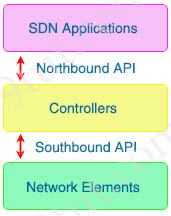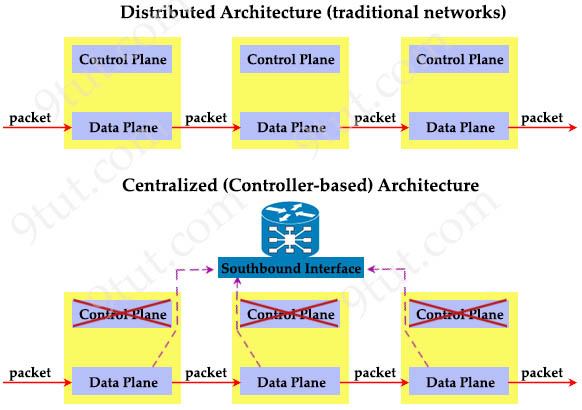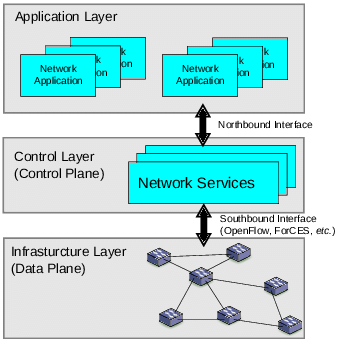SDN Questions
|
SDN Quick Summary Everything that networking devices do can be categorized into three planes: Data Plane, Control Plane and Management Plane. Most traditional devices use a distributed architecture, in which each control plane is resided in a networking device. Therefore they need to communicate with each other via messages to work correctly. In contrast to distributed architecture, centralized (or controller-based) architectures centralizes the control of networking devices into one device, called SDN controller. Software-Defined Networking (SDN) is an approach to networking that centralizes the control plane into an application called a controller. As we took the control planes off networking devices but not data planes so we need a way to communicate with them. So we put a southbound interface (SBI) at the bottom of SDN controller for this task. An SBI communicates with the devices via an application programming interface (API).
Now, in turn, the networking administrators and SDN applications want to control the controller! So the controller need a northbound interface (NBI) to communicate with us. The NBI applications included various network services, including network virtualization, dynamic virtual network provisioning, firewall monitoring, user identity management and access policy control.
– REST (Representational State Transfer) describes a type of API that allows applications to sit on different hosts, using HTTP messages to transfer data over the API. SDN northbound APIs are usually RESTful APIs used to communicate between the SDN Controller and the services and applications running over the network. Another northbound API is Simple Object Access Protocol (SOAP). OpenFlow and NETCONF are Southbound APIs used for most SDN implementations. Another Southbound API is OpFlex, which is an open-standard, distributed control system. It send “summary policy” to network elements. |
Question 1
Question 2
Explanation
The Southbound API is used to communicate with network devices.

Question 3
Question 4
Explanation
OpenFlow is a well-known southbound API. OpenFlow defines the way the SDN Controller should interact with the forwarding plane to make adjustments to the network, so it can better adapt to changing business requirements.
The Network Configuration Protocol (NetConf) uses Extensible Markup Language (XML) to install, manipulate and delete configuration to network devices.
Other southbound APIs are:
+ onePK: a Cisco proprietary SBI to inspect or modify the network element configuration without hardware upgrades.
+ OpFlex: an open-standard, distributed control system. It send “summary policy” to network elements.
Question 5
Explanation
Most traditional devices use a distributed architecture, in which each control plane is resided in a networking device. Therefore they need to communicate with each other via messages to work correctly.
In contrast to distributed architecture, centralized (or controller-based) architectures centralizes the control of networking devices into one device, called SDN controller -> Answer D is correct.

Question 6
Explanation
Control Plane Function
In its simplest form, the control plane provides layer-2 MAC reachability and layer-3 routing information to network devices that require this information to make packet forwarding decisions. In the case of firewalls, the control plane would include stateful flow information for inspection. Control plane functionality can implemented as follows:
+ Distributed – Conventional routers and switches operate using distributed protocols for control, i.e. where each device makes its own decisions about what to do, and communicate relevant information to other devices for input into their decision making process. For example, the Spanning Tree Protocol (STP), Fabric Path, and routing protocols such as IS-IS and BGP provide distributed control of packet forwarding functionality to networking devices.
+ Centralized – In this case, a centralized controller provides the necessary information for a network element to make a decision. For example, these controller(s) instruct networking devices on where to forward packets by explicitly programming their MAC and FIBs.
Reference: https://www.cisco.com/c/en/us/td/docs/solutions/Enterprise/Data_Center/VMDC/SDN/SDN.html
Question 7
Question 8
Explanation
The Open Networking Foundation identifies three main parts of the Software-defined networking (SDN): Application layer; Control layer and Infrastructure layer. SDN separates a router’s control plane from the data (forwarding) plane. The control plane makes routing decisions. The data plane forwards data (packets) through the router. With SDN routing, decisions are made remotely instead of on each individual router.




This material is relatively new; I was not prepared for this at CCNP level, at the time I had to recertify I failed, came back to the CCNA and feel ready.